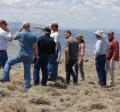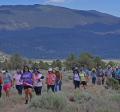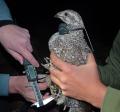Coordination
The Collaborative Philosophy
The key components of this collaborative, multi-jurisdictional work include 1) a foundation of engaged stakeholders through the Local Area Working Group (LAWG), 2) a science-based and adaptive strategy through the Technical Advisory Committee (TAC), 3) a coordinated interagency approach through the Executive Oversight Committee (EOC), 4) a sustained collaborative effort that is mature and effective, and 5) a “roadmap to conservation” to assure certainty of effectiveness and implementation of conservation actions (Bi-State Action Plan).
This collaborative effort is a sophisticated model for voluntary conservation as it reflects the truism that applied conservation is an art. Science provides the factual basis and guidance, and is implemented in a social and regulatory context that is hard on the problem, easy on the people, and ultimately accomplishes the shared vision. The Bi-State effort has navigated this political and scientific landscape, and found a pathway that engages the people on the land in the direct conservation of the species.
The Collaborative Structure
The LAWG provides a forum for coordinating a landscape level approach to BSSG conservation and management, and developed the first conservation plan in 2004. The 2004 plan identified a strategy for sage-grouse conservation, identified and prioritized risks, and specified projects to address the risks as they were known at that time.
In 2011, the Executive Oversight Committee (EOC) was established to engage the administration and leadership of natural resource management agencies and ensure a coordinated conservation effort across jurisdictional boundaries. The EOC established the Technical Advisory Committee (TAC) in late 2011, consisting of agency biologists, to provide technical expertise and guidance. The TAC revised the 2004 conservation plan into the 2012 Bi-State Action Plan (BSAP), with the assistance and input of the LAWG and EOC. View the BSSG collaborative structure.
Agency Funding Commitments
Each year, Bi-State partners work together to leverage expertise and develop conservation strategies to develop a proposed program of work based on priority, staff availability and funding. Agencies work across jurisdictional boundaries to monitor population demographics, complete vegetation monitoring plots and carry out Action Plan projects.
In 2014, Bi-State partners announced a $45 million-dollar commitment to implement the 2012 Action Plan over a 10-year period and complete the highest priority 76 projects (Figure 25, Table 7). Under the direction of the Executive Oversight Committee, each partnering agency drafted a commitment letter to the Service, stating their acknowledgment of responsibility and dedication to implement a coordinated interagency approach to conservation. Agency partners have recently updated their letters to extend an additional five years, demonstrating their ongoing commitment to Bi-State sage-grouse conservation. View the updated commitment letters here.




